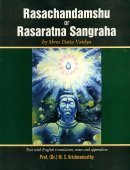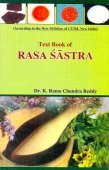Rajavarta, Rajan-avarta, Rajan-varta, Rājāvarta, Rājavarta: 10 definitions
Introduction:
Rajavarta means something in Hinduism, Sanskrit, the history of ancient India, Marathi. If you want to know the exact meaning, history, etymology or English translation of this term then check out the descriptions on this page. Add your comment or reference to a book if you want to contribute to this summary article.
In Hinduism
Ayurveda (science of life)
Rasashastra (Alchemy and Herbo-Mineral preparations)
Source: Wisdom Library: Rasa-śāstra1) Rājāvarta (राजावर्त, “lapis lazuli”):—One of the eight mahārasa (‘superior minerals’), according to the Rasaprakāśasudhākara: a 13th century Sanskrit book on Indian alchemy, or, Rasaśāstra.
2) Rājāvarta (राजावर्त, “lapis lazuli”) or Rājāvartarasa is the name of a Ayurvedic recipe defined in the fifth volume of the Rasajalanidhi (chapter 20, Madyapana: evil effects of wine ). These remedies are classified as Iatrochemistry and form part of the ancient Indian science known as Rasaśāstra (medical alchemy). However, since it is an ayurveda treatment it should be taken with caution and in accordance with rules laid down in the texts.
Accordingly, when using such recipes (e.g., rājāvarta-rasa): “the minerals (uparasa), poisons (viṣa), and other drugs (except herbs), referred to as ingredients of medicines, are to be duly purified and incinerated, as the case may be, in accordance with the processes laid out in the texts.” (see introduction to Iatro chemical medicines)
Source: Indian Journal of History of Science: Rasaprakāśa-sudhākara, chapter 4-5The best Rājāvarta (‘Lapis lazuli’) is that which is slightly reddish, bluish or mixed colours, heavy in weight and masṛṇa (smooth) on surface. It is dīpana (stimulates digestive fire), pācana (digestive) vṛṣya (aphrodisiac), pacifies vāta-doṣa and viṣa-doṣa, destroys kaphaja-rogas, pramehas, arśas, pāṇḍu and kṣaya-rogas.

Āyurveda (आयुर्वेद, ayurveda) is a branch of Indian science dealing with medicine, herbalism, taxology, anatomy, surgery, alchemy and related topics. Traditional practice of Āyurveda in ancient India dates back to at least the first millenium BC. Literature is commonly written in Sanskrit using various poetic metres.
India history and geography
Source: Cologne Digital Sanskrit Dictionaries: Indian Epigraphical GlossaryRājāvarta.—(SII 2; SITI), a kind of gem; lapis lazuli; same as vaiḍūrya. Note: rājāvarta is defined in the “Indian epigraphical glossary” as it can be found on ancient inscriptions commonly written in Sanskrit, Prakrit or Dravidian languages.

The history of India traces the identification of countries, villages, towns and other regions of India, as well as mythology, zoology, royal dynasties, rulers, tribes, local festivities and traditions and regional languages. Ancient India enjoyed religious freedom and encourages the path of Dharma, a concept common to Buddhism, Hinduism, and Jainism.
Languages of India and abroad
Marathi-English dictionary
Source: DDSA: The Aryabhusan school dictionary, Marathi-Englishrājāvarta (राजावर्त).—m An inferior sort of diamond.
Marathi is an Indo-European language having over 70 million native speakers people in (predominantly) Maharashtra India. Marathi, like many other Indo-Aryan languages, evolved from early forms of Prakrit, which itself is a subset of Sanskrit, one of the most ancient languages of the world.
Sanskrit dictionary
Source: DDSA: The practical Sanskrit-English dictionaryRājāvarta (राजावर्त).—a diamond of an inferior quality.
2) a diamond from Virāṭa country.
Derivable forms: rājāvartaḥ (राजावर्तः).
Rājāvarta is a Sanskrit compound consisting of the terms rājan and āvarta (आवर्त).
--- OR ---
Rājavarta (राजवर्त).—cloth of various colours.
Derivable forms: rājavartaḥ (राजवर्तः).
Rājavarta is a Sanskrit compound consisting of the terms rājan and varta (वर्त).
Source: Cologne Digital Sanskrit Dictionaries: Benfey Sanskrit-English DictionaryRājāvarta (राजावर्त).—m. an inferior kind of diamond. Ṣoḍaśāvarta, i. e.
Rājāvarta is a Sanskrit compound consisting of the terms rājan and āvarta (आवर्त).
Source: Cologne Digital Sanskrit Dictionaries: Monier-Williams Sanskrit-English Dictionary1) Rājavarta (राजवर्त):—[=rāja-varta] [from rāja > rāj] m. cloth of various colours, [cf. Lexicographers, esp. such as amarasiṃha, halāyudha, hemacandra, etc.]
2) Rājāvarta (राजावर्त):—[from rāja > rāj] m. (once n.) Lapis Lazuli, [Bālarāmāyaṇa]
3) [v.s. ...] a kind of diamond or other gem (of an inferior quality, said to come from the country Virāṭa, and regarded as a lucky possession though not esteemed as an ornament; = rāja-maṇi, [Varāha-mihira’s Bṛhat-saṃhitā [Scholiast or Commentator]]; also topala m., [Kathāsaritsāgara])
4) [v.s. ...] n. cloth of various colours, [cf. Lexicographers, esp. such as amarasiṃha, halāyudha, hemacandra, etc.] (cf. rāja-v).
[Sanskrit to German]
Sanskrit, also spelled संस्कृतम् (saṃskṛtam), is an ancient language of India commonly seen as the grandmother of the Indo-European language family (even English!). Closely allied with Prakrit and Pali, Sanskrit is more exhaustive in both grammar and terms and has the most extensive collection of literature in the world, greatly surpassing its sister-languages Greek and Latin.
Kannada-English dictionary
Source: Alar: Kannada-English corpusRājāvarta (ರಾಜಾವರ್ತ):—[noun] an azure-blue, opaque semiprecious stone, considered as of inferior quality for purpose of ornament, but regarded as a lucky possession; lapis lazuli.
Kannada is a Dravidian language (as opposed to the Indo-European language family) mainly spoken in the southwestern region of India.
See also (Relevant definitions)
Partial matches: Varta, Avarta, Rajan, Raja.
Starts with: Rajavartapa, Rajavartarasa.
Query error!
Full-text: Ratnapancaka, Nripavarta, Rajavarti, Rajavartarasa, Rajavartopala, Rajatyavartaka, Rajavartman, Suvarnabha, Avartanamani, Curonaracavarttam, Brahmavarta, Pancaratna, Maharasa, Avarta.
Relevant text
Search found 20 books and stories containing Rajavarta, Raja-varta, Rāja-varta, Rajan-avarta, Rājan-āvarta, Rajan-varta, Rājan-varta, Rājāvarta, Rājavarta; (plurals include: Rajavartas, vartas, avartas, āvartas, Rājāvartas, Rājavartas). You can also click to the full overview containing English textual excerpts. Below are direct links for the most relevant articles:
Rasa Jala Nidhi, vol 3: Metals, Gems and other substances (by Bhudeb Mookerjee)
Part 1 - Characteristics of Lapis lazuli (rajavarta < [Chapter XXV - Gems (15): Rajavarta (quartz amethyst or lapis lazuli)]
Part 2 - Purification of Rajavarta < [Chapter XXV - Gems (15): Rajavarta (quartz amethyst or lapis lazuli)]
Part 4 - Extraction of essence of Rajavarta < [Chapter XXV - Gems (15): Rajavarta (quartz amethyst or lapis lazuli)]
Rasa Jala Nidhi, vol 4: Iatrochemistry (by Bhudeb Mookerjee)
Part 13 - Treatment of Piles (12): Trailokya-tilaka rasa < [Chapter V - Piles]
Treatment for fever (115): Kasturi-bhusana rasa < [Chapter II - Fever (jvara)]
World Journal of Pharmaceutical Research
Areview article on suryakanta mani < [2021: Volume 10, March issue 3]
Representation of rasadravyas in the modern periodic table. < [2023: Volume 12, September issue 15]
A review article on ayurved prakash < [2022: Volume 11, May issue 5]
Role of gems in indian medicine < [Volume 10 (issue 3), Jan-Mar 1991]
Minerals and Metals in Sanskrit literature (by Sulekha Biswas)
4.11. Two Softer Blue Gems of the Ancient World < [Chapter 7 - A millennium of Ratnashastra (gemmology) literature in India]
12. Iatro-Chemical Texts < [Chapter 8 - Non-gem Minerals and Metals in Rasa-shastra]
Appendix E - Technical words in the post-Christian era Indian literature
Rasa Jala Nidhi, vol 5: Treatment of various afflictions (by Bhudeb Mookerjee)
Chapter 20 - Symptoms and Treatment of Madya-pana-vikara
Part 25 - Ar-Razi and the Indian knowledge of metallic chemistry < [A Brief History of Indian Chemistry and Medicine]
Related products

